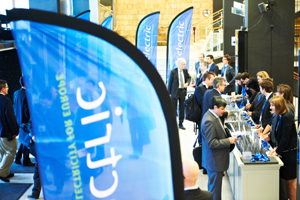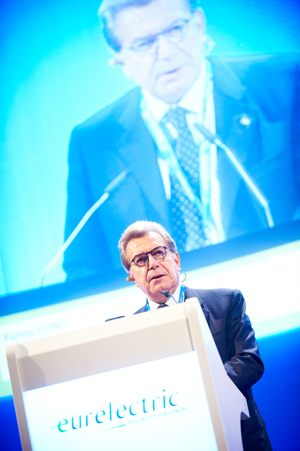An industry plagued by uncertainty, waiting for political leadership
on
Impressions from the Eurelectric conference in Stockholm
An industry plagued by uncertainty, waiting for political leadership
‘Europe we need you!’ The European electricity industry is crying out for political leaders that can usher in the long-awaited, liberalised and integrated European energy market. But at a gathering of industry leaders, the mood was fairly sombre. As one top consultant expressed it: ‘If we don’t get some form of protection or support, we are not going to see enough investment.’
 |
| Eurelectric conference in Stockholm (Photo: David Plas) |
The ‘key question’ facing the industry, Josefsson said, is ‘public opinion’. The key issue, he later added, ‘is the political ability to lead. We need a common European vision.’
The themes Josefsson sounded – the need for European unity and political leadership in these highly turbulent times – would recur again and again in the two long summer days in the Swedish capital. ‘We need a more integrated European market’, proclaimed Fulvio Conti, CEO of Italian Enel and incoming President of Eurelectric. ‘A common integrated approach is needed.’
‘We need to be on a European path’, echoed Johannes Teyssen, CEO of German energy producer Eon and Vice-President of Eurelectric. Frank-Detlef Drake, Vice-President Corporate Research & Development of Eon’s big rival RWE spoke in the same vein. ‘We have to think internationally. We have to leave national considerations behind’, he said. But he noted that ‘the trend at this moment is the reverse.’
Oluf Ulseth, CEO of Energy Norway, put things even more starkly. ‘We need more Europe!’ he declared.
The audience, consisting mostly of representatives from the European electricity sector, could not agree more. When, in a voting session, they were asked the question ‘What will be the most important constraint to well-functioning electricity markets’, among four options they chose overwhelmingly for ‘focus on national control’.
Green growth
The concerns of the European electricity industry are not hard to understand. For one thing, they are confronted by policymakers with highly ambitious climate policies. The Swedish State Minister of Industry Daniel Johansson said that the ‘key to success’ would be to ‘decouple economic growth from greenhouse gas emissions’.
The audience was also shown a video with a message from Connie Hedegaard, the European Commissioner for Climate Action, and Lord Nicolas Stern, author of the famous Stern Review, both of whom underlined the supreme importance for Europe of moving to a decarbonized future. Later during the conference Herman van Rompuy, President of the European Council, also appeared on video, with a similar message. Europe has the world’s ‘most ambitious climate programme’, he boasted, and this ‘in the midst of an economic crisis’. This means, said Van Rompuy, that ‘we believe in a new model of growth – green growth’.
And that’s not all the electricity industry has on its plate. In addition to being set the task of ‘transforming’ itself into an engine of ‘green growth’, it is also expected to ensure a secure and affordable energy supply for Europe. Indeed, in his opening speech Conti indicated that security of supply is the industry’s highest priority.
To meet these combined challenges, requires – as everyone knows by now – massive investments. As Matias Alonso, Global Managing Director of the Utilities Industries Group of Accenture said in his presentation, in the renewable energy sector alone €1400 billion of investments in new-built generation capacity are needed until 2050 to make the EU’s decarbonisation dream come true. That’s excluding investments in back-up capacity and grid expansion and excluding investments in alternative low-carbon options, such as nuclear power.
Whether these investments will be forthcoming, depends on ‘two things’, Conti said: ‘a stable and predictable long-term regulatory framework’ and ‘a level playing field for markets to allow and reward efficient innovative projects.’
The problem is: neither the stable political framework nor the level playing field currently exist in Europe. For example, when it comes to renewable energy, every member state has its own support schemes, which are based purely on national considerations. These national programmes interfere with the functioning of the EU’s Emission Trading Scheme, which was set up precisely to create a level playing field and direct investments torwards the lowest-cost renewable energy options. For this reason, Ulseth of Energy Norway urged political leaders to make their renewable energy programmes ‘coherent with other energy and climate policies’. In particular, he pleaded to make the EU’s Emission Trading Scheme (ETS) ‘the most important driver’ of European energy and climate policy.
Politicians defend the national subsidy schemes because they argue that taxpayers in one country would not want to pay for subsidies in other countries. But Teyssen of Eon wondered, ‘if the Spanish can buy German cars, why can’t we buy Spanish solar power?’ The heavy subsidies for solar power in Germany are cited by many as a prime example of a market distortion, as Germany is geographically not the most optimal place in Europe to be stimulating this form of renewable energy.
Unanimous support
Speaking at the conference, Energy Commissioner Günther Oettinger conceded that ‘delivering investments is our greatest challenge’ and acknowledged that the energy sector faces great uncertainties, but he assured the audience that the Commission’s response ‘to all this uncertainty is to ensure that the political and regulatory framework is as clear and as certain as it can be’. He said that the European Council in February had demonstrated that this ‘framework’ has ‘the unanimous support of the heads of stae and government of all member states’. He recalled that the European Council has set 2014 as the deadline for ‘completing the internal market’.
 |
| Fulvio Conti, new President of Eurelectric: 'Go for energy technology' (Photo: David Plas) |
A more basic problem is that politicians are increasingly perceived by industry leaders as unreliable. They are seen as being led more by national public opinion polls than by rational arguments or promises they made in Council meetings in Brussels.
This fickleness creates enormous difficulties for the energy companies. Thus, for example, although Eurelectric may subscribe to the European Commission’s ambitious climate targets, the organisation emphasizes that the goals cannot be reached without a substantial role for nuclear power and carbon capture and storage (CCS). This was underlined by Alonso of Accenture, who said that ‘in a sustainable EU, nuclear power should stay in the mix’. He noted that €410 billion of investments are needed in the nuclear power sector merely to roughly maintain the current position nuclear energy has in the power mix.
But it is precisely in these controversial areas, of nuclear power and CCS, that policymakers are most prone to waver in the face of public opposition. The German nuclear reversal is the most obvious example of course, but it is by no means the only one. To mention just one other example, Vattenfall is running into major opposition in its crucial CCS plans in Germany. In the Netherlands, too, CO2-storage has been stymied by political obstruction.
As Drake of RWE succinctly put it – ‘our biggest challenges are political and social’.
Pump-prime
Some of the top consultants who gave presentations at the conference were frankly sceptical about whether the electricity industry would be able to make the transformation policymakers are hoping for. ‘Is there enough capital to handle the investment challenge?’ asked Stephen Vaughan, Managing Director of the Utilities Advisory Practice of Rothschilds, and he declared himself to be ‘relatively pessimistic’ about this.
He noted that the ‘big six’ utility companies were cutting back on capital investments. ‘So long as these companies constitute the only substantial source of capital, we are going to have a problem.’ Vaughan said that governments would need to consider ‘pump-priming’ measures: ‘If we don’t get some form of protection or support, we are not going to see enough investment.’
Alonso of Accenture, who looked at the effects the liberalisation of the European electricity market have had so far, was also rather sombre about the state of the market. Although competition has led to efficiency gains, he said, it has had little effect on end user prices. Morever, he noted that competition had ‘eroded capacity margins’, that Europe had become ‘more dependent’ and that there had been ‘insufficient energy intenstiy reductions so far’. He warned that ‘the more ambitious the low carbon agenda’ is, ‘the more investment will be required’. Like Stephen Vaughan he could see a ‘significant capacity gap’ emerging if no firm action is taken.
As if all this was not alarming enough, Nobuo Tanaka, Executive Director of the International Energy Agency (IEA), had another grim message for the audience. ‘The age of Cheap Energy’, he declared, ‘is over!’ Policymakers, he added, must explain this brutal fact to the public. Mark Lewis, Managing Director Commodities Research of Deutsche Bank, likewise declared that governments need to be honest with their citizens about the future prices of energy.
But it was clear that most people in Stockholm felt that the idea that our present-day political leaders are going to get out there with this message, seems unlikely. ‘We are living in the age of permanent (election) campaigns’, Lewis said, ‘which disconnects from the real life-cycle.’ Øystein Løseth, CEO of Vattenfall, seemed to feel that it was much more likely that ‘the market’ will get blamed if anything goes wrong. ‘It worries me that people are so skeptical about the market’, he said.
Temperemental
So what hope is there that all these looming challenges can somehow be met? Certainly one big hope is the promise of ‘smart grids’. As Alonso put it hopefully, ‘Demand side management will be a key to reduce consumption and flatten the load curve – and partially reduce investment requirements.’ The Distribution System Operators (DSO’s) that are part of Eurelectric even devoted a separate session to the subject, but although the assembled experts made it clear they believe in the bright prospects of smart grids, they also had to concede there is still a long way to go before those prospects become reality. Everyone agreed that the big question mark for smart grids is how consumers will respond to them. This is a puzzle that has not been solved yet.
In any case, smart grids alone will not be able to save the day. Conti hammered on the importance of innovation across the board. ‘Go for every technology. Go for innovation. Then politicians will follow.’ But the new Eurelectric chief also promised that, if circumstances require, he will not hesitate to pound his fist on the table in Brussels.
It seems that for Eurelectric the cool Swedish approach under Josefsson will be succeeded by a more temperemental one under Conti. The times are probably ripe for such a change. We will probably know more by next year, when Eurelectric’s Annual Conference will take place in Malta.
Author's note: it is worth checking out the speech Sam Laidlaw, CEO of British energy producer Centrica, gave at the Economist Energy summit on 23 June. According to Laidlaw, the 'clock is ticking' on the UK energy market. He gives five recommendations for policymakers to avert a disaster. See here.
|
Highlights from Commissioner Oettinger's speech at the Eurelectric conference I welcome the theme for this year's conference. Delivering investments is our greatest challenge – investments in energy supply, infrastructure and demand reduction. Investments in the energy sector take years to come to fruition. The decisions we take today will undoubtedly shape the world in 2050. The more we need to make the right choices and carefully balance our approach. In the interests of security and sustainability of our planet, governments across the world have set a low-carbon goal: To reduce emissions by at least 80% by 2050. The EU wants to lead the way towards this goal. And every investment decision we take today can help us do so. |


Discussion (0 comments)